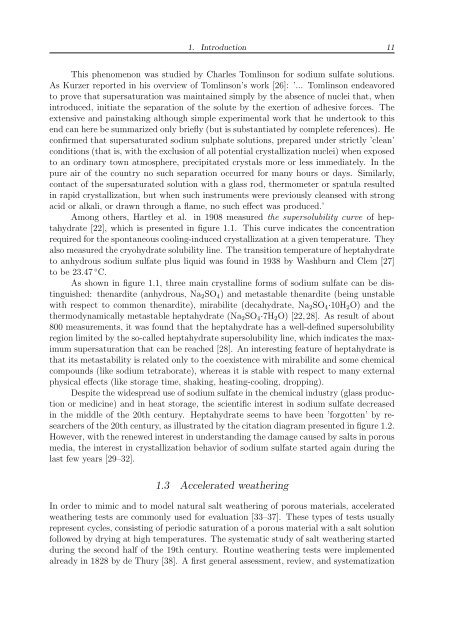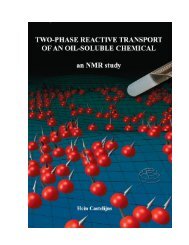P - Technische Universiteit Eindhoven
P - Technische Universiteit Eindhoven
P - Technische Universiteit Eindhoven
You also want an ePaper? Increase the reach of your titles
YUMPU automatically turns print PDFs into web optimized ePapers that Google loves.
1. Introduction 11<br />
This phenomenon was studied by Charles Tomlinson for sodium sulfate solutions.<br />
As Kurzer reported in his overview of Tomlinson’s work [26]: ’... Tomlinson endeavored<br />
to prove that supersaturation was maintained simply by the absence of nuclei that, when<br />
introduced, initiate the separation of the solute by the exertion of adhesive forces. The<br />
extensive and painstaking although simple experimental work that he undertook to this<br />
end can here be summarized only briefly (but is substantiated by complete references). He<br />
confirmed that supersaturated sodium sulphate solutions, prepared under strictly ’clean’<br />
conditions (that is, with the exclusion of all potential crystallization nuclei) when exposed<br />
to an ordinary town atmosphere, precipitated crystals more or less immediately. In the<br />
pure air of the country no such separation occurred for many hours or days. Similarly,<br />
contact of the supersaturated solution with a glass rod, thermometer or spatula resulted<br />
in rapid crystallization, but when such instruments were previously cleansed with strong<br />
acid or alkali, or drawn through a flame, no such effect was produced.’<br />
Among others, Hartley et al. in 1908 measured the supersolubility curve of heptahydrate<br />
[22], which is presented in figure 1.1. This curve indicates the concentration<br />
required for the spontaneous cooling-induced crystallization at a given temperature. They<br />
also measured the cryohydrate solubility line. The transition temperature of heptahydrate<br />
to anhydrous sodium sulfate plus liquid was found in 1938 by Washburn and Clem [27]<br />
to be 23.47 ◦ C.<br />
As shown in figure 1.1, three main crystalline forms of sodium sulfate can be distinguished:<br />
thenardite (anhydrous, Na 2 SO 4 ) and metastable thenardite (being unstable<br />
with respect to common thenardite), mirabilite (decahydrate, Na 2 SO 4·10H 2 O) and the<br />
thermodynamically metastable heptahydrate (Na 2 SO 4·7H 2 O) [22, 28]. As result of about<br />
800 measurements, it was found that the heptahydrate has a well-defined supersolubility<br />
region limited by the so-called heptahydrate supersolubility line, which indicates the maximum<br />
supersaturation that can be reached [28]. An interesting feature of heptahydrate is<br />
that its metastability is related only to the coexistence with mirabilite and some chemical<br />
compounds (like sodium tetraborate), whereas it is stable with respect to many external<br />
physical effects (like storage time, shaking, heating-cooling, dropping).<br />
Despite the widespread use of sodium sulfate in the chemical industry (glass production<br />
or medicine) and in heat storage, the scientific interest in sodium sulfate decreased<br />
in the middle of the 20th century. Heptahydrate seems to have been ’forgotten’ by researchers<br />
of the 20th century, as illustrated by the citation diagram presented in figure 1.2.<br />
However, with the renewed interest in understanding the damage caused by salts in porous<br />
media, the interest in crystallization behavior of sodium sulfate started again during the<br />
last few years [29–32].<br />
1.3 Accelerated weathering<br />
In order to mimic and to model natural salt weathering of porous materials, accelerated<br />
weathering tests are commonly used for evaluation [33–37]. These types of tests usually<br />
represent cycles, consisting of periodic saturation of a porous material with a salt solution<br />
followed by drying at high temperatures. The systematic study of salt weathering started<br />
during the second half of the 19th century. Routine weathering tests were implemented<br />
already in 1828 by de Thury [38]. A first general assessment, review, and systematization
















